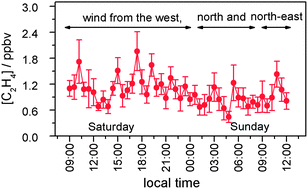Development and application of an optical sensor for ethene in ambient air using near infra-red cavity ring down spectroscopy and sample preconcentration
Abstract
An automated near infra-red (

* Corresponding authors
a
School of Chemistry, University of Bristol, Cantock's Close, Bristol, UK
E-mail:
a.orr-ewing@bristol.ac.uk
Fax: +44 (0)117 925 0612
Tel: +44 (0)117 928 7672
An automated near infra-red (

 Please wait while we load your content...
Something went wrong. Try again?
Please wait while we load your content...
Something went wrong. Try again?
M. S. I. Aziz and A. J. Orr-Ewing, J. Environ. Monit., 2012, 14, 3094 DOI: 10.1039/C2EM30801K
To request permission to reproduce material from this article, please go to the Copyright Clearance Center request page.
If you are an author contributing to an RSC publication, you do not need to request permission provided correct acknowledgement is given.
If you are the author of this article, you do not need to request permission to reproduce figures and diagrams provided correct acknowledgement is given. If you want to reproduce the whole article in a third-party publication (excluding your thesis/dissertation for which permission is not required) please go to the Copyright Clearance Center request page.
Read more about how to correctly acknowledge RSC content.
 Fetching data from CrossRef.
Fetching data from CrossRef.
This may take some time to load.
Loading related content
